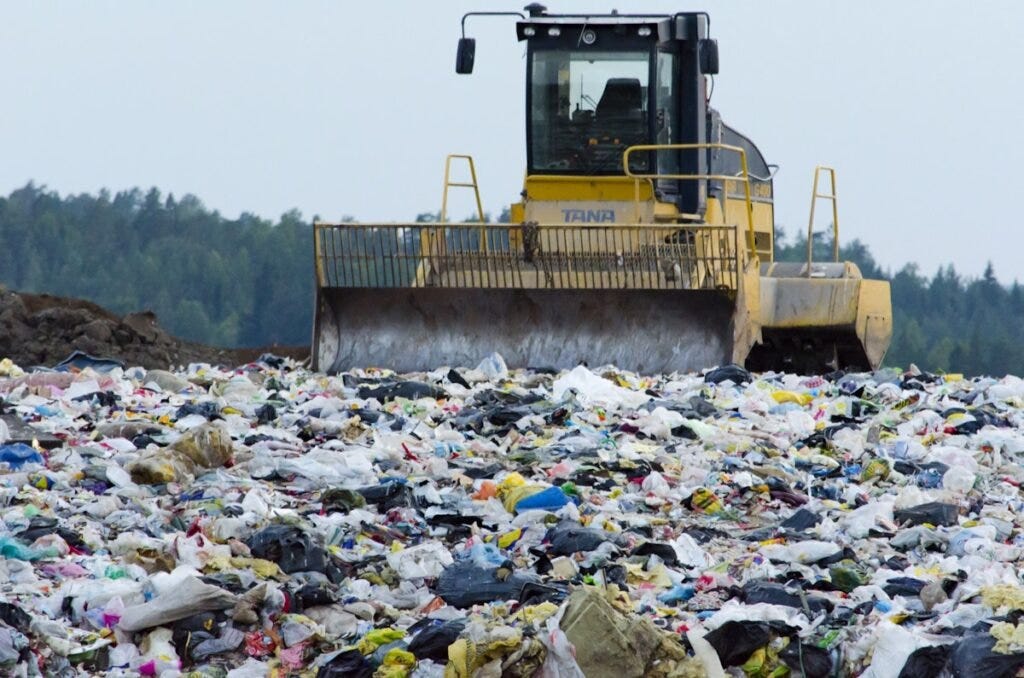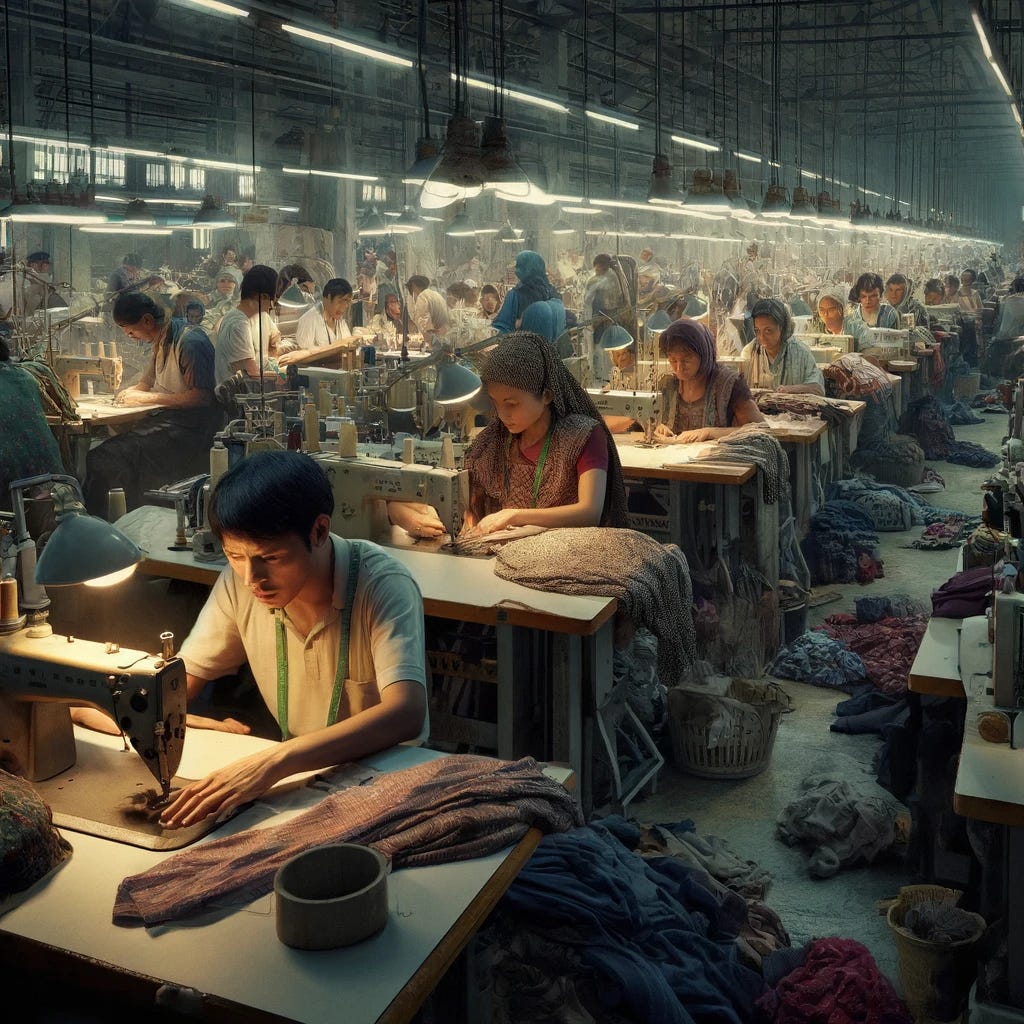Clothing production has doubled since 2000 and with a shifting population and consumption patterns, the fast fashion industry is expected to continue to grow. By 2030, one estimate suggests that clothing consumption will grow 63% along with a rise since 2015 of 2.4 billion people into the global middle class, and a recent report estimated the world is on track to triple clothing production by 2050.
Fast fashion—the mass production of cheap, disposable clothing—has transformed the way we buy and wear clothes. While it enables consumers to keep up with the latest trends at a low cost, this convenience comes at a significant environmental price. The industry's impact is profound, affecting everything from water resources to waste management, and even contributing to climate change.
Water Consumption and Pollution
The production of fast fashion items consumes an enormous amount of water. A single cotton shirt, for example, can require up to 2,700 liters of water — the equivalent of what an average person drinks over two and a half years. Moreover, the fashion industry is one of the largest consumers of water globally, accounting for 20% of all global wastewater.
Water pollution is another critical issue. The dyeing and treatment of garments lead to toxic chemicals being dumped into waterways. These practices are particularly harmful, affecting both aquatic life and the health of communities relying on these water sources.

Fashion is one of the most polluting of all industries in general. Clothing is manufactured with highly toxic dyes and heavy metals that are flushed into clean water streams, rivers and aquifers where they sicken people and animals, harm ecosystems, and cause biodiversity loss.
The industry razes 150 million trees for cellulosic fabrics. Cattle grazing has contributed to deforestation in the Amazon and the leather produced from that region has been traced to global fashion brands’ shoes and bags.
Use of Non-Renewable Resources
Fast fashion relies heavily on non-renewable resources, particularly petroleum, to produce synthetic fibers like polyester and nylon. These materials are favored in the fast fashion industry due to their low cost and versatility, but they are not biodegradable. As a result, discarded garments accumulate in landfills, where they may take hundreds of years to decompose, releasing harmful gases like methane, a potent greenhouse gas, in the process.
Carbon Footprint
The fashion industry is responsible for approximately 10% of global carbon emissions, with fast fashion playing a significant role due to its high volume production model. The long supply chains and energy-intensive production processes significantly contribute to its carbon footprint. From the manufacture of synthetic fibers to international shipping and the energy used in retail stores, every step in the lifecycle of a fast fashion garment uses energy, mostly derived from fossil fuels.
The fashion industry is responsible for 4% of greenhouse gas emissions – the same as the countries of Germany, France and the U.K. combined. Unchecked, fashion production would account for 26% of all carbon emissions by 2050.
Waste Generation
The fashion industry produces 100 billion garments a year and 87% (40 million tons) end up in a landfill where they smolder and pollute the air or an incinerator. Only 1% of all discarded clothing is actually recycled. The average person today buys 60 percent more items of clothing than they did 15 years ago, but keep them for only half as long. The average garment may be worn as few as ten times before disposal.
The fast fashion model encourages consumers to view clothes as disposable. As new trends come in, old clothes are often discarded. In the U.S. alone, over 15 million tons of used textile waste is generated each year, of which about 85% ends up in landfills. The rapid turnover of apparel contributes to this waste, which is problematic not only in terms of landfill use but also resource wastage and environmental pollution.
Social Impact
The environmental impact of fast fashion is tied closely to its social implications, including labor exploitation and unsafe working conditions in many developing countries. The true cost of fast fashion’s cheap clothing is extracted from the industry’s factory garment workers. Workers are paid less than the minimum wage in countries in the global south which does not nearly constitute a “living” wage. Raising awareness about these issues can drive more consumers towards sustainable fashion practices.
Rethinking Fashion: Embracing Upcycling and the Circular Economy
In response to the burgeoning environmental crises exacerbated by the fast fashion industry, a transformative shift towards upcycling and circular economy practices is gaining momentum. These innovative approaches not only aim to mitigate the detrimental effects of traditional fashion production but also envision a more sustainable and ethical future for the industry.
Upcycling: Breathing New Life into Old Materials
Upcycling represents a creative and environmentally conscious solution to the waste generated by fast fashion. Unlike recycling, which often involves breaking down products to their base materials, upcycling transforms waste into products of equal or higher quality without degrading the original materials. This process not only reduces the need for new raw materials but also decreases waste and emissions associated with traditional manufacturing.
Designers and innovative brands are at the forefront of this movement, turning discarded fabrics and garments into high-fashion pieces. These upcycled collections challenge the notion that eco-friendly fashion must compromise on style or quality. By incorporating unique, repurposed materials, designers create one-of-a-kind items that tell a story and promote sustainability.
Circular Economy: A Systematic Shift in Fashion
The circular economy model takes the concept of upcycling a step further by redesigning the entire lifecycle of fashion products. This approach focuses on designing out waste, keeping products and materials in use, and regenerating natural systems. It represents a holistic shift from the traditional, linear "take-make-waste" model to one that is regenerative by design.
Key elements of the circular economy in fashion include:
- Design for Longevity: Creating garments that are timeless in design and durable in construction, encouraging longer use and reducing the frequency of replacement.
- Material Innovation: Developing new, sustainable materials that can be fully recycled or that biodegrade naturally without harming the environment.
- Product as a Service: Offering services like leasing or renting clothes, which provides consumers with the flexibility to change outfits without owning them, thus reducing the volume of clothing produced and discarded.
- Reverse Logistics: Establishing efficient systems for the return and reuse of used garments, either through resale, recycling, or upcycling.
Industry Leaders and Innovators
Several pioneering brands and designers are leading the charge towards a more sustainable fashion industry through upcycling and the circular economy. For instance, Patagonia’s Worn Wear program encourages customers to trade in their used gear, which is then repaired and resold. Similarly, brands like Eileen Fisher and H&M have introduced take-back programs, where old garments are collected, recycled, or upcycled into new products.
Other initiatives such as Trashy Creative Reuse shop offers creators and designers a range of quality rescued fabrics and leathers for use in the creation of new fashion items. In addition, Trashy Preloveds has sourced and curated quality preloved clothes for sale, further reducing waste from the fashion industry finding its way to landfill.
Consumer Participation: The Role of Awareness and Choice
Consumer awareness and choices play a crucial role in driving the fashion industry towards sustainability. By choosing to support brands that prioritize eco-friendly practices, consumers can influence broader industry standards.
Consumers have the power to change the trajectory of fast fashion. Here are a few important things you can do:
Educate yourself about sustainable clothing.
Buy less and shop for quality over quantity.
Choose natural materials – organic cotton, linen, or hemp.
Buy 100% recycled fabrics – 100% recycled polyester, viscose (rayon), etc.
Research brands to identify those that are ethical and practice transparency and sustainability.
Post a picture of yourself wearing a sustainable garment, explaining its attributes and why you like it. Tag us on social media!
Choose brands that are manufactured in their own community and connected to the place, people behind them, local economy, and environment.
Buy secondhand clothing.
Swap clothes with a clothes swap group or start a swap yourself.
Learn how to repair your clothes yourself. The longer clothes are kept, the lower their emissions footprint.
The shift towards upcycling and a circular economy in the fashion industry is not just a trend but a necessary evolution to address the environmental challenges posed by fast fashion. By rethinking how garments are designed, used, and reused, we can create a sustainable fashion system that not only preserves our planet but also enhances our relationship with the clothes we wear. As we continue to innovate and adapt, the dream of a fully sustainable, circular fashion industry.
References
Md. Jubair Hasan. October 3, 2023. How Much Water Does It Take to Make a T-Shirt? Jazzy Journal by Jubair
Bailey, Kerrice, Aman Basu, and Sapna Sharma. 2022. "The Environmental Impacts of Fast Fashion on Water Quality: A Systematic Review" Water 14, no. 7: 1073. https://doi.org/10.3390/w14071073)
Fast Fashion. Clean Up, Australia.
Fashion for the Earth. Earthday.org
Trashy is at Shop 4, 92-112 Henry Street, Penrith
https://www.trashyresourcerescue.com.au/







